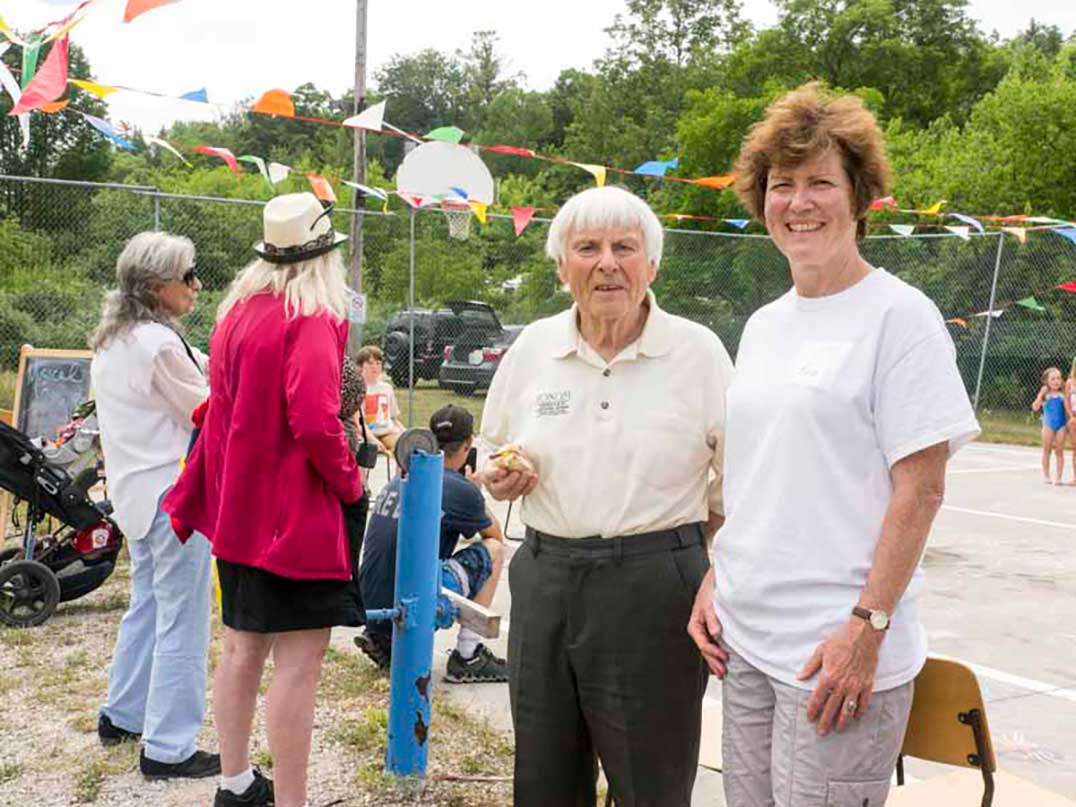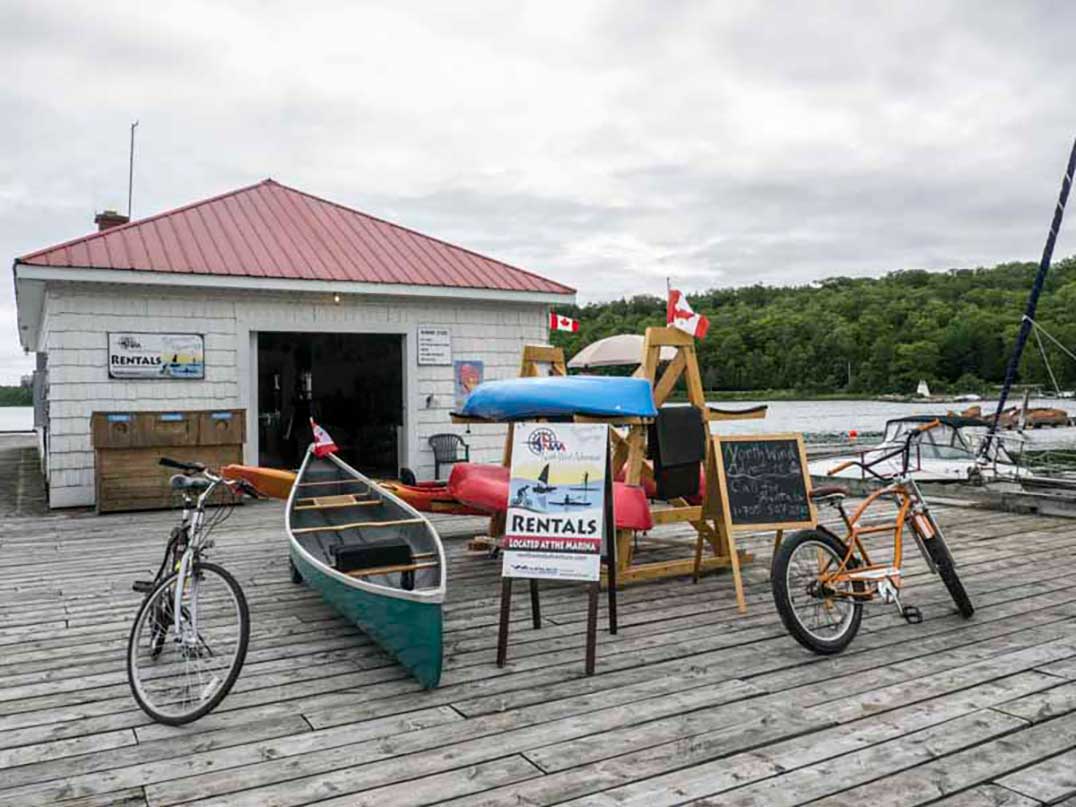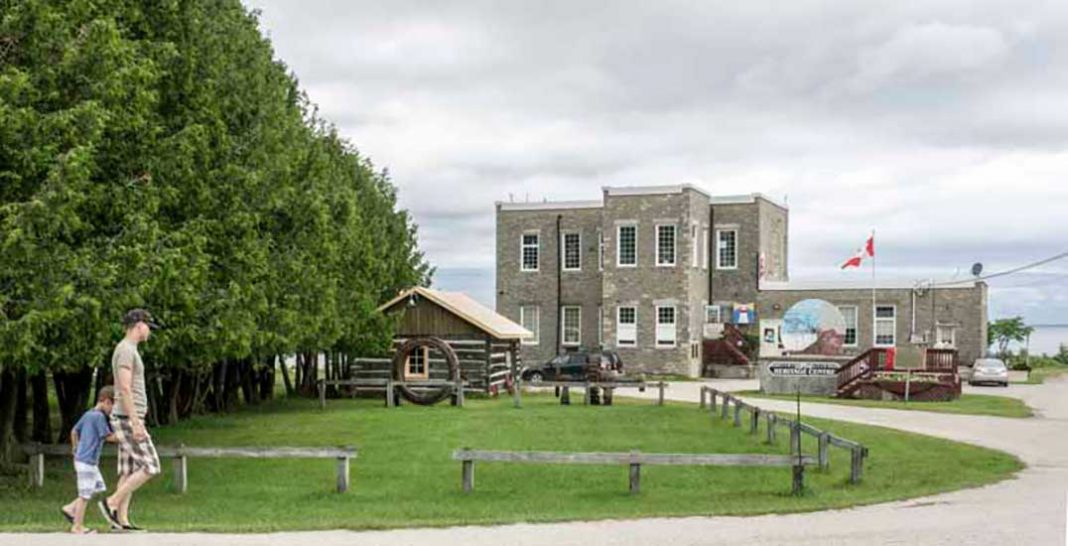by Isobel Harry
KAGAWONG—Kagawong, named by the original Ojibwe inhabitants who lived here long before the town was surveyed in 1867, means “where mists rise from the falling water.” Today, Bridal Veil Falls is the emblem of the community, a destination popular year-round with residents and visitors for its ancient escarpment formed by the Kagawong River plunging 20 metres into an inviting shallow pool below.
Situated off Highway 540 in Billings Township, Kagawong boasts a storied past and a dynamic creative community that is bringing new life to the chronicles of ‘Ontario’s Prettiest Village.’
Historical structures abound, starting at the hilltop entrance to the village with the stone building built in 1902 to serve as Billings School No. 1, now the Main Street Café, scene of coffee klatsches and evening concerts under hot-pink patio umbrellas.
Down the hill, Bridal Veil Falls are to your right as you cross the bridge over the bucolic Kagawong River, launching place of canoes, kayaks and fishing boats.

photos by Isobel Harry
Kagawong’s first lumber mill, built on this site in 1873 by Irish settlers William and Robert Henry, also ground grain into flour at a time when settlers painstakingly had to grind their own grain by hand at home. Following the deaths of the mill’s original owners, the mill was sold to James Carter, whose imposing residence, built in 1899, well-maintained and now painted deep green, stands on the northwest corner of Highway 540. Occasionally, the house is opened by the current owners to sell their stock of antiques and collectibles.
The Riverside Take-out Stands offers fresh Manitoulin whitefish and fries on picnic tables and in gazebos; the nostalgic sweets at the Boo-Bah-Lou Candy Corner and the all-natural creams and potions of Bare Naked Beauty are a short stroll away.
Continuing down the hill (after a quick turn left past the fire station to visit Kagawong’s first church, St Paul on the Hill, opened in 1884), through deep cuts in prehistoric striated rock, you will pass the Park Centre on the right where community events are held. A series of brightly painted pop-up shops display their wares here, just as you find yourself on Lower Main Street.
Most of the buildings on Lower Main Street were built after a devastating fire in 1892 destroyed almost all of the town’s existing structures. Manitoulin Chocolate Works sells fine handcrafted Belgian chocolates from the former stables. A stone block building with an enclosed upper balcony was built by Hugh Brown as a butcher shop in 1925 and has served as a restaurant, poolroom and grocery store; it is now a private residence and artist studio.
Next door is the former Havelock Hotel, built in 1896 by John Hilliard. The large three-storey white-painted structure with gables and green trim seems to defy time, and once had a fabled reputation as a fishing resort, with 15 rooms and two bathrooms.

recreation committee, in checking out Kagawong’s Summer Fest activities, taking place this July 15-16.
Billings Township Mayor Austin Hunt’s general store and post office, built after the fire and then called Snow’s store, still welcomes shoppers for everyday conveniences. At age 91, Mr. Hunt is the longest serving municipal politician in Canada, actively engaged in steering the direction of his community and often spotted strolling the town. The Kagawong Light Tower, built by the federal Department of Marine and Fisheries and first lit in 1894, stands across from the marina, whose boat docks are a great spot to view the sand beach and North Channel activities. North Wind Adventure rents kayaks, canoes, stand-up paddle boards, bicycles and sailboats at the marina’s front door.
St. John the Evangelist Church, originally the Snow’s store warehouse, was built in 1898. Its belfry boasts a bell from a locomotive, a ship’s wheel from a pulp barge that sank in the bay hangs over the door, the pulpit is the bow of a boat wrecked at Maple Point with four fatalities (a reminder of our mortality), and the buoys on the pews came from the Graham Brothers’ fishing enterprise.

The Old Mill, built in 1925 of local limestone to serve as a pulp mill, houses the municipal offices on the ground floor; the second floor is home to Edwards Studios and Fine Art Gallery, offering pottery, jewellery, wood carvings, textiles and paintings.
The adjacent Heritage Centre (open every day from 10 am to 4 pm) brings historical exhibits to life in a multi-media environment, depicting local contributions to both world wars, early schools and the booming boating and fishing industries of the mid-19th century. In honour of the 150th anniversary of Canadian Confederation, the Lester B. Pearson Exhibit displays personal items of the former Prime Minister on loan from the National Archives of Canada in an authentic replica of his Ottawa office at Laurier House. The Historic Speakers Series kicks off July 12 at the Park Centre with author and broadcaster Steve Paikin of TVO’s ‘The Agenda.’ (For information: www.kagawongmuseum.ca; email oldmillheritage@billingstwp.ca; telephone 705-282-1442.)
Outside the Old Mill is a tiny log cabin housing the Post Office Museum for Transportation and Communication and nearby an open-air pavilion hosts the weekly farmers’ market on Wednesdays from 11 am to 3 pm.
The municipal recreation committee is extremely active, and plans Kagawong’s old-fashioned Summerfest (July 15-16, 2017), among many other events. The town also is blessed with the creative energies of many artisans and original minds devising ways to engage culturally with the town and the Island. Check out the River Bend Stage and the Main Street Café’s music nights, the library’s movie nights and the innovative programs at 4elements Living Arts (4e), located next to the fire station, for excursions in the ‘Outside the Box’ series, workshops, walks, talks and paddling skills sessions all “combining appreciation for the land with the arts.”
Local experts and educators lead 4e outings, adding photography, writing, drawing, painting or “sun-printing” to each adventure. The River School, four half-day sessions on Wednesday mornings, are designed for children ages 7-12 to learn about simple plant and tree identification, river flow, algae, mud and fossils.

photo by Isobel Harry
This year, 4elements’ Billings Art and Heritage Trail project chose several artists in a competition to create public work and heritage plaques on the 3 km Kagawong River Trail that runs through the village, throughout the village proper, and at parks, on the waterfront and cycling rest areas all over the township by the fall of 2017. The ever-growing Elemental Festival (September 29-October 1, 2017), with ‘Reconciliation’ as this year’s theme, will engage audiences with musical events, art installations and the unveiling of the Billings Art and Heritage Trail. Visit http://4elementslivingarts.org or connect with the 4elements team on social media; telephone (705) 282-0444; email info@4elementslivingarts.org
For more about Kagawong and the township of Billings: http://billingstwp.ca/
For maps and events listings, pick up free copies of ‘This is Manitoulin’ and ‘Manitoulin’s Magazine 2017’ at many shops, tourist information booths and on the ferry.




